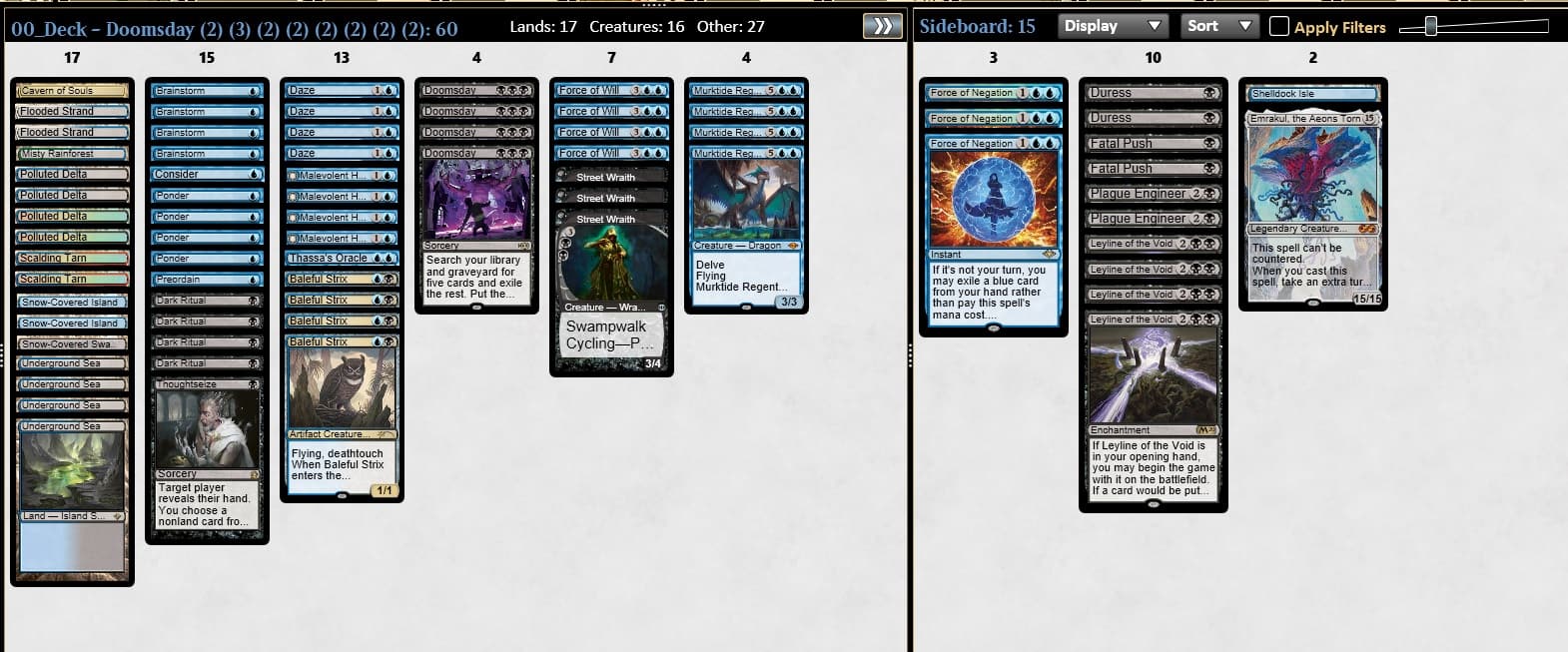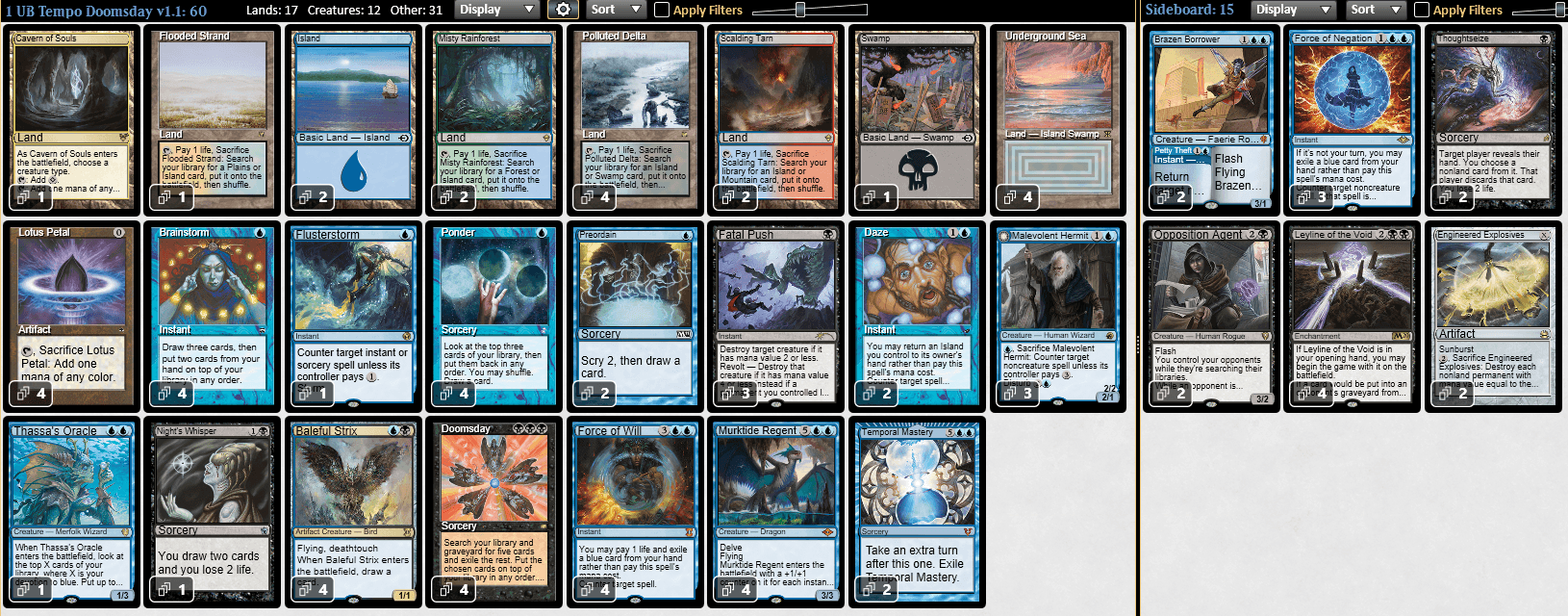I haven't been this excited about a deck since .
Origins
A week ago, Italian Legacy grinder TrueHero tweeted a 5-0 with a take on that made my brain explode.

Traditionally, "slow" lists leverage cards like in order to stall the game and generate card advantage while finding / clearing the way for the combo. TrueHero's list went a step further: it used to give the fair plan some real wings, so to speak. As another card to bridge both the fair and unfair game plans, he included a pair of , since while s function nicely as a way to cycle through a pile, they also excel at turning a into a very lethal threat.
Initial Tuning + Grixis Tempo Doomsday
As excited as I was, I had a few issues with TrueHero's initial list: The s (aside from churning through the pile) didn't do much outside of hurt your life total. With no s or , the corner-case benefit of , which is to cast with UU left over, have in hand, and cycle into (as long as you have enough devotion to make up for the fact that your library isn't empty), didn't seem worth it to me.
Also, the 3-drop slot was oversaturated, and , which is a cool card in theory, doesn't fly. Since Ragavan's ban, the entire Delver threatbase flies, so I didn't like accelerating into a 3-drop that's supposed to stabilize your board but essentially has "can't block" written on the card.
At the time I saw the list, I was extremely high on the card . Between Delver, Daybreacher, and even , has a ton of value across the board, and blue decks have never been more susceptible to the card. I wanted to play 4-6 copies in my 75 for the PTQ that was coming up in a few days.
My brain immediately went to as the perfect card for this sort of list. It filters your deck to find when you need it (and bin it when you don't), fills your graveyard for , attacks alongside the dragon to deal 20 damage (especially when combined with ). It also enables some really clean wins (, bin a card, , bin a card, ).
Once I added a color to this deck, I couldn't support basic lands, and I converted the s into s to support the color requirements, as well as play nicely with DRC's surveil and delirium abilities. I went 5-0, 4-1, and 4-1 in leagues to vet and tune the deck, and played the following list in the PTQ:

I ended up 6-3, beating Reanimator, UR delver twice, Death & Taxes, Oops All Spells, 8-Cast, and lost to some explosive draws from Turbo Karnforge, fast protected kills by a Turbo Doomsday build, and lost games 2 and 3 to a Hogaak deck when i couldn't find despite mulliganing low. In summary, I won every game the deck played Magic, and that's remarkable.
That same day, Yamayama won the Saturday challenge with the following UB Tempo Doomsday list:

The Crusher
With my previously established bias against the cycling spells, and seeing 0 Temporal Masteries in the winning list, I concluded that must be really fucking good. I made a few changes from Yamayama's list before launching it into a league:
Cyclers out, Temporal Masteries in.
Add to the main deck as another thing to out, act as recurring removal, regrowing creatures ( is a prime target), and do some cute things with the -2 ability and piles.
Cut the 4th for the first . I like the as a way to accelerate out the fair game plan, such as play a around opposing , or leave up a activation.
Cut / from the sideboard. There isn't a control deck in the format that doesn't play a bunch of or . I don't think the plan works consistently enough to be worth 2 sideboard slots.
Add and to the sideboard (more on these cards later).
I proceeded to enter a league and rattled off the easiest 5-0 I've had since was legal. And despite how good I thought might be, it somehow outperformed even those expectations. It reads like and plays like . Its front side is a relevant clock, and its activated ability of "U: Counter target noncreature spell unless its controller pays 3," as an ability, is functionally "uncounterable" back. It even works while the opponent controls a . The back side is just as good, as a 2/2 Flying body that makes all of your noncreature spells uncounterable, incidentally beating things like . It's pretty trivial to win with when your opponent can't counter any of your stuff. It's also worth noting that on Wizard works for both sides of while still working for .
This deck doesn't seem to lose. At the time of writing, I'm at 22 wins and 3 losses with the deck, with the ability to trace all 3 losses to mulligan or play decisions that I made.
How is this deck so good? It turns out that Delver decks (or more broadly, Blue tempo decks) and have opposite matchup profiles, and you can change roles to play as whatever deck your opponent doesn't want to face. Against GW Depths or Death and Taxes, you're a deck. Against Delver, you're a UB tempo deck that swings the pseudo-mirror with a pile of es and (postboard) . Against Delver in Game 1, you can even on Dragon to make sure your s can take over the game. I don't think there's a deck that's actively good against both Delver and , at least with in the picture. No. Bad. Matchups.
It's nice that the two gameplans, while looking incongruent at first glance, actually have a ton of little synergies that let the deck play a lot more smoothly than it might appear to do on paper. Here's a few examples:
gets pumped whenever an instant or sorcery leaves your graveyard. 's resolution exiles all remaining cards from your graveyard and library, meaning that your s get pumped by however many instants and sorceries leave your graveyard at the time of resolution.
's body functions nicely for the fair game plan, and is innately a 2-for-1 as your opponent expends resources to (attempt to) answer both halves of the card. Meanwhile, either side effectively protects your ability to combo, and as mentioned before, Cavern on Wizard works here and with .
can turn a into a lethal threat before your opponent gets a turn, and can be either set up by or by casting and stacking your library. At this point, you stack a couple on top of your pile and still have the as a contingency plan.
also allows you to build functional piles that beat (since y exiles itself) and draw limiters like (since you're taking extra turns and not drawing extra cards). To play around , for instance, a pile of , , , , casts with an empty library and only 2 cards in your graveyard.
The extra devotion granted by your creatures means that you can often play a with extra cards in the library and still win through potential removal.
Card Choice Rundown
This deck is still pretty early in its development, but I'll give a rundown of the cards I think you can reasonably include and the reasoning behind them (sorted by mana cost, low to high)
Maindeck:
17-18 lands: Everyone's playing 17, but decks usually play 1-2 too few lands in the early stages of their development, and I can't see why this would be an exception.
4 and 4 : They're legal. Come on now.
3 and 1 : I brought up the split rationale earlier, and I like this split to hedge between the two game plans.
0-1 : Good for piles if you're playing or , and great at recurring and .
0-1 : Good with , and can be an extra cantrip to help smooth out a deck that's perhaps a bit on the clunkier side.
0-2 : Better than at sculpting, worse than consider at feeding t or shenanigans.
0-4 : Pressures planeswalkers and combo decks. Cavern on Wizard. Removal magnet. I'm not sure if it's right to include actual factual Delver, but right now I'm playing 3.
0-2 : Discards planeswalkers and combo pieces. Takes removal to protect your Murktides or countermagic for your . As it's a liability against Delver, I'm currently not playing any, but could see that being wrong.
3-4 : A great card in both the fair and unfair gameplans. The reason to play fewer than 4 is that the deck is pretty mana-hungry and casting a bunch of them early might not be feasible in order to get your 2-drops down in time.
0-1 : Card advantage, good with piles, good with , good with and against . The downside is that it's yet another 2-drop (see below).
4 : A key part of not dying while digging through your deck. Also, piles can sometimes be a few followed by a and .
3-4 : While it's really good against Blue decks, it's legitimately bad against stuff like Death and Taxes. The reasons to play under 4 as a nonblue metagame concession or to thin out the number of 2-drops.
1-2 : Card advantage. Can't be ed. Important in that basic pile of , , , , .
1-2 : It has a trigger that says "win the game" on it.
4 : Wins the matchups the rest of the deck doesn't.
0-1 : Extra thing to use with , repeatable removal, recurs your creatures, and can do cute things post- like -2 with your last two cards in library (including ), which you then regrow and cast. In conjunction with , you can sometimes sneak up to 7 loyalty and ultimate before your opponent expects it, which, with few exceptions, does win the game. I'm not going to lie, this is a pet card of mine.
0-1 : It's a pet card, but not mine. I've seen some lists with it and it, like Liliana, is another non- thing to combine with . I'm not a fan of it because the ground creature decks can get much bigger than the Witch and the Insects can offer, while against Delver decks, as their entire threat-base flies, and the insects essentially read "can't block.
4 : Controversial, I know.
0-1 : For the fair gameplan, you can essentially play a 0-mana "2-for-2" where you misdirect your opponent's removal spell to their own creature. For the unfair gameplan, it functions as an extra if you're protecting your own spells. The question becomes how many s you want to play.
4 : This deck is going to get Murktide Regent banned.
2-3 : The glue that holds this deck together. When drawn at non-ideal times, try to set it up for some massive combat combos with a mid-game or pitch it to .
Sideboard:
In lieu of a sideboard guide (cards are too much in flux for me to actually map a 75), I will provide sideboard cards and the matchups they are for.
Alright, here's a little bit of sideboard guide: cut the entire combo against Delver. It's closer to a liability, and you sometimes want to avoid even casting in Game 1. That said, I do keep the as a bit of a hedge against mana denial and as a tool to help cast stuff like on curve without fear of . Now back to the list of sideboard cards:
3-4 : Graveyard decks and UR Delver. It turns off both and , neutering Delver's ability to generate a reasonable clock.
2 : Delver, creature decks, Hullbreachers.
2-3 : Tribal decks, Delver (on Human), the mirror (on Wizard or Bird). Really good with .
2 : Combo. Could also be if you're less concerned about losing before you take your first turn.
2 , 1 : Combo and control.
1 : Great against opposing triggers, but more importantly is instrumental at ensuring you can get to your own. stops , , , , , and various other niche cards that people say on Twitter that can't beat. It can also be used to disrupt key points in an opponent's gameplan like a or activation, or a or trigger. It can still, of course, be used to grief opponents when it's in your opening hand, on the play, and your opponent is foolish enough to open on a fetch land.
1 : Mostly for Marit Lage and Hasty 5/5 indestructible Germ tokens, but is also good as a catch-all for various hate cards, while the 3/1 body plays nicely into the fair game plan.
Other people are playing some copies of , which is obviously great in the mirror, as well as against things like and . I think they're good but am sadly still limited to 15 sideboard cards.
My Recommended List, Updated March 18, 2022:

Piles:
This deck doesn't have any fancy piles. draws 2 cards. adds to the board and replaces itself. is a 0 mana cycler that lets you make extra land drops and exiles itself. Make sure you put (and probably ) in there, too.
Whether you're a fair Blue player, combo player, or a GW Depths player having an identity crisis, I hope this article gives you the resources you need to get started with UB Tempo Doomsday.
